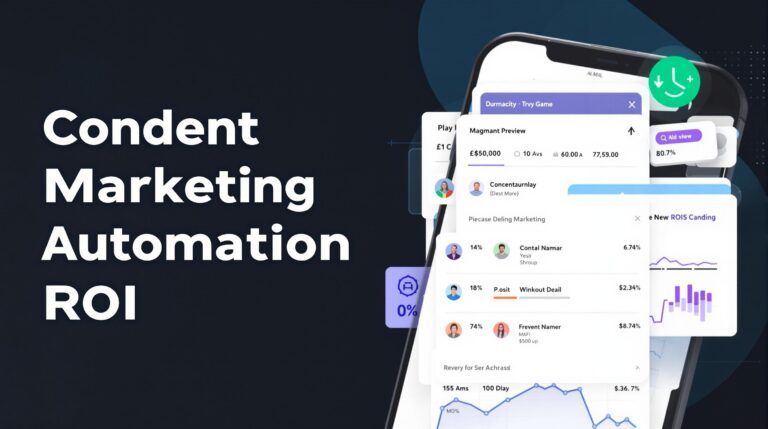How to Automate Your Blog Content Creation in 5 Simple Steps
Automated content creation has revolutionized how businesses approach their blog strategies in today’s digital landscape. With 7.5 million blog posts published daily and the average post requiring four hours to create, leveraging AI blog writing solutions and streamlined processes has become essential for scaling content production without sacrificing quality.
Key Takeaways
- Content automation can reduce writing time by 40-60% while maintaining quality
- A structured 5-step approach makes blog automation tools accessible to businesses of all sizes
- Proper integration between AI tools and human oversight creates the most effective content systems
- Businesses using automation generate 67% more B2B leads than non-blogging competitors
- Regular performance monitoring ensures your automated content continues improving over time
Why Blog Automation Matters in Today’s Digital Landscape
The content creation challenge facing digital marketers grows more demanding each year. With 7.5 million blog posts published daily, standing out requires both quantity and quality. The typical blog post demands four hours to write—time many businesses simply don’t have. This explains why annual spending on marketing automation tools is projected to reach $25.1 billion.
Automation doesn’t mean replacing human creativity but enhancing it. By identifying repetitive tasks that consume valuable time, teams can focus on strategy and audience engagement while letting AI handle routine aspects of production. This balanced approach helps businesses scale content output without sacrificing the personal touch readers expect.

Step 1: Audit Your Content Workflow to Identify Automation Opportunities
Before implementing automation, you need to understand your current process. Start by mapping out each step from ideation to publication. According to industry research, 64% of B2B marketers outsource blog copywriting—an expense that can be reduced through strategic automation.
Look for tasks that are repetitive, time-consuming, or prone to bottlenecks. Common candidates for automation include:
- Keyword research and topic generation
- Content outlining and first drafts
- SEO optimization
- Image sourcing
- Publication scheduling
Use tools like Google Analytics and SEMrush to analyze your content performance metrics. Pay attention to average engagement time (typically 52 seconds per post) and which headline lengths perform best (6-13 words achieve optimal CTRs). These insights will help you establish a baseline against which to measure your automation efforts.
Step 2: Select the Right AI Content Generation Tools for Your Needs
The market for blog automation tools has expanded dramatically, with options for every budget and skill level. Modern AI writing platforms like Journalist AI and BrandWell can produce impressive results quickly—with BrandWell generating 3,000-word posts in under 10 minutes.
When evaluating tools for automated content creation, prioritize these key features:
- SEO optimization capabilities that integrate with your keyword strategy
- Plagiarism detection to ensure original content
- CMS integration options (especially WordPress plugins)
- Customizable templates that match your brand voice
- Editing and revision capabilities
Different tools serve different purposes in your workflow. ChatGPT excels at ideation and generating draft variations, while specialized platforms offer end-to-end publishing solutions. For connecting systems, Activepieces provides no-code workflow automation that can link AI drafts directly to your WordPress site.
Step 3: Build Your Automated Content Production Pipeline
Creating an effective content automation pipeline involves three key stages. First, standardize your inputs with templates and brand voice guidelines. This provides the AI with consistent direction and helps maintain quality across all posts.
Second, implement batch processing using keyword clusters. This approach allows you to plan and generate multiple related posts simultaneously, potentially producing 50-100 posts monthly. The efficiency gains are substantial—businesses using automation typically maintain a publishing cadence of 3-6 posts monthly without increasing staff.
Third, establish quality gates to ensure automated content meets your standards:
- Grammar and style checks using tools like Grammarly
- Plagiarism scanning with Copyscape
- SEO scoring before publication
- Human review for sensitive topics or brand voice alignment
Setting up direct CMS integrations completes the pipeline, allowing approved content to flow straight to your blog. This streamlined process helps explain why blogs achieve 67% more B2B leads than non-blogging competitors, as reported by OptinMonster.
Step 4: Optimize Your Content for Both Search Engines and Readers
AI blog writing tools now offer sophisticated SEO capabilities that go beyond basic keyword insertion. Dynamic optimization strategies include Latent Semantic Indexing (LSI) with tools like Clearscope, which identifies related terms to enhance topical authority.
Automating meta tags via WordPress plugins like Yoast SEO can boost CTRs by 21% when headlines contain 6-8 words. This approach saves time while improving performance. Another underutilized strategy is automated content refreshing—only 38% of marketers update older articles, despite the proven SEO benefits.
Don’t limit automation to text content. Integrate multimedia to enhance engagement:
- Canva API for automated featured images
- Descript for creating video summaries from blog text
- Automatic chart generation from data points
Articles with videos attract three times more backlinks according to research. While implementing these automated enhancements, ensure your content still meets E-E-A-T guidelines, balancing AI efficiency with the expertise and authority Google values.
Step 5: Monitor Performance and Scale Your Automation System
The final step is setting up robust monitoring systems to track how your automated content performs. Create analytics dashboards that focus on key performance indicators relevant to your goals—whether traffic, conversions, or engagement metrics.
According to industry data, 60% of marketers struggle with content engagement. Use this insight to implement A/B testing for crucial elements like headlines, calls-to-action, and media formats. Let data guide your automation strategy refinements.
Scale your system through cross-platform syndication. Tools like Zapier can automatically distribute your blog content to social media channels and email newsletters, multiplying your content’s reach. Businesses using such automation report twice as much email traffic.
Most importantly, create feedback loops to continuously improve your AI outputs. Machine learning thrives on data—the more you refine your system based on performance, the better your automated content will become over time.
Managing the Human-AI Balance in Your Content Strategy
Effective blog automation doesn’t eliminate the human element—it enhances it. While automation can reduce content production costs by 40-60%, strategic human oversight remains essential. Successful implementations report 1,000+ daily views through consistent, SEO-optimized posts that balance efficiency with authenticity.
Reader preferences support this balanced approach, with 62.96% of audiences favoring multi-author blogs that offer diverse perspectives. Reserve human creativity for high-impact areas:
- Strategy development and audience research
- Personal stories and case studies
- Expert interviews and opinion pieces
- Final editing and quality assurance
The most successful automation systems redirect human resources toward strategic thinking and audience engagement rather than eliminating team members. This approach maximizes both efficiency and content effectiveness.
Getting Started: Your First Week of Blog Automation
Beginning your automation journey doesn’t have to be complicated. Start with a focused one-week implementation plan that builds momentum through quick wins. Day one should focus on auditing your current process and selecting your initial automation tools.
By mid-week, set up your first templates and test basic AI-generated drafts. Use this phase to establish quality guidelines and train team members on the new workflow. Focus on automating a single content type before expanding to your entire blog strategy.
Common pitfalls to avoid include:
- Over-automating without quality checks
- Using generic templates that lack brand personality
- Neglecting to train AI on your specific voice and standards
- Failing to measure baseline metrics for comparison
By the end of your first week, aim to have a complete test post that’s moved through your automated system from concept to publication. Use this experience to refine your process before scaling to your full content calendar.
Sources
brandwell.ai – How Can You Automate Your Blog Content
tryjournalist.com – Automate Blog Posts
optinmonster.com – Blogging Statistics
tryjournalist.com – Automated Blog Posting
tryjournalist.com – AI Blog Automation
tryjournalist.com – How To Automate Content Creation
activepieces.com – Automate Blog Writing With AI
contentbot.ai – The 5 Stages Of Setting Up An Effective Workflow Automation








